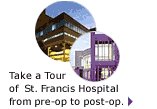 |
Microdiscetomy
In general, a herniated lumbar disc is a fragment of disc
material that has exuded through a tear in the covering
surrounding it. The disc fragment exudes out and presses
upon a nearby nerve to create pain and disability. Deciding
whether or not to have surgery for the disc herniation
depends upon the amount of disability the person is experiencing
and the neurological signs an individual might have. With
a herniated lumbar disc, patients will many times be given
a course of conservative care to include rest at home,
physical therapy, chiropractic manipulation, or epidural
steroid injections. Should one or more of these measures
fail to improve the patient significantly, the patient
will then go on for a diagnostic study such as an MRI
or an immediate evaluation by a neurosurgeon.
The
best radiographic study for evaluation of continued
back and leg pain is an MRI. The MRI demonstrates disc,
nerve, and bone. It can also evaluate possible other
causes of back and leg pain such as tumor or infection.
For patients who are extremely claustrophobic, the MRI
can be a problem. Many times these patients can manage
getting through the MRI with a sedative prescribed by
their referring physician. Other patients find it so
difficult that they will ultimately require other studies
such as CT scan or a myelogram.
Presuming
the MRI does demonstrate a herniated disc, the issue
still remains as to whether or not surgery might be
recommended for a particular patient. When making a
decision for or against a recommendation of surgery
to the lumbar spine, the neurosurgeon assesses a variety
of factors. These factors include the length of time
that the patient has been experiencing pain, the location
of the pain (is it limited to the back, or does it travel
down into the leg and into the foot), and the presence
of neurological signs. These neurological signs can
occur along with the pain or even independent of pain.
These signs include weakness in the leg, numbness and
tingling in the leg, and problems controlling the bladder
or bowel. Generally, if any patient has a problem controlling
their bladder or bowel, this can be considered an emergency,
and the patient should contact their doctor for immediate
evaluation. If the numbness or weakness in the leg is
becoming progressively more severe, the patient should
also let their doctor know urgently.
Patients
oftentimes ask what has happened to the herniated disc
when they feel that they are improved and will not need
surgery. Generally, the disc material shrinks in size,
there is relief of pressure on the nerve, and therefore
the symptoms that the patient was experiencing improve.
Patients generally feel better within a few weeks after
a period of initial pain with conservative nonoperative
management. At times, however, the improvement is only
partial, with patients unable to perform their full
activities. Although improved, these patients should
seek further evaluation.
Whether
or not you decide to have a back operation, you should
have a clear picture of your level of pain and neurological
deficit. In addition, if surgery is considered, a detailed
discussion with the operating surgeon should include
what kind of surgery is going to be performed, the indication
for performing the operation (exactly why am I getting
this surgery), the goals of the operation, the alternatives
to performing this particular operation, the limitations
of the operation (what might the surgery not be able
to improve, (e.g., chronic low back pain over years)),
and finally, the risks of the surgery. Following a discussion
of this sort, the patient should feel free to go home
and discuss this further with his or her family, write
down any questions that they might have, and either
call or revisit the surgeon with further questions.
The
technique of the laminotomy and microdiscectomy is a
commonly performed back operation with over a 90 percent
chance of improvement of pain and symptoms in the patients
receiving the surgery.
A
small incision is made in the back with the patient
either asleep or under spinal anesthesia. The muscle
immediately underneath is dissected to expose the roof
of the bone (lamina). This lamina is over the top of
the nerve. Small portions of this bone are then removed
to expose the nerve underneath. The nerve is then dissected
and held to one side, and the disc fragment that had
exuded out and pressed upon the nerve is then removed.
At this point, the surgeon can remove some more disc
material within the disc space if he or she feels that
further disc material might exude out to hurt the patient
again. No matter how aggressively the removal of the
disc material within the disc space is performed, there
will always be some remaining disc material left behind.
Most of the patients receiving the microdiscectomy and/or
laminotomy go home a day after surgery. Some patients
have been able to be discharged the day of surgery.
The
recuperation depends upon the individual patient working
with his or her surgeon postoperatively. Each person
recuperates at a different pace. One factor to consider
is the amount of heavy activity that the person expects
to perform following their surgery. For example, an
individual returning to desk work might return much
earlier than another individual who is constantly lifting
heavy objects and bending while at work. In addition,
depending upon the individual's level of postoperative
pain and function, physical therapy and/or chiropractic
manipulation to assist a patient postoperatively can
be requested by the surgeon after evaluating the patient
in the office.
|
 |
